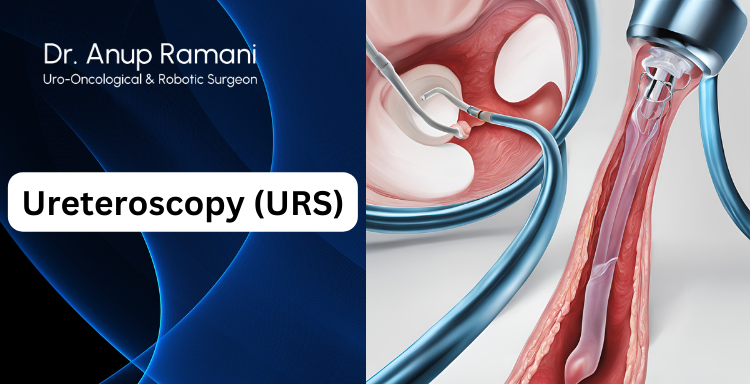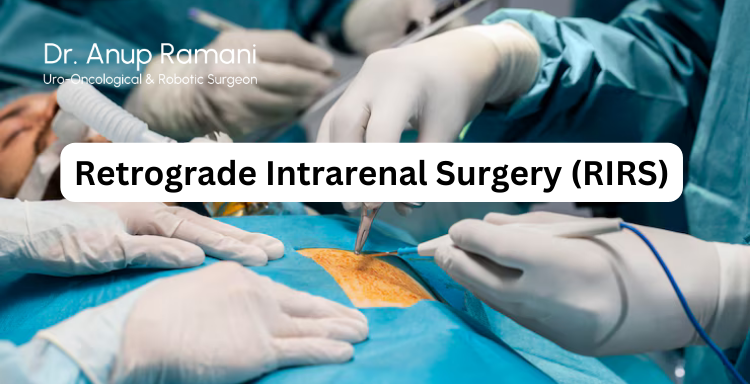Dr Anup Ramani @ Copyright 2024
By Dr. Anup Ramani
Kidney stones are a common and painful condition that affects millions of people worldwide. When stones become too large to pass naturally or cause complications, surgical intervention is often required. Among the most effective procedures for kidney stone removal are Ureteroscopy (URS) and Retrograde Intrarenal Surgery (RIRS).
Both methods are Minimal invasive, but they differ in approach, scope, and suitability depending on the patient’s specific situation. In this article, we’ll explore the differences between URS and RIRS, helping patients understand the best surgical option for treating their kidney stones.
Understanding Kidney Stones
Kidney stones are hard deposits of minerals and salts that form inside the kidneys. They can vary in size, ranging from tiny grains to larger stones that block the urinary tract, causing pain, infection, or kidney damage. While smaller stones often pass naturally through urine, larger stones may require surgical treatment to prevent serious complications.
What is Ureteroscopy (URS)?
Procedure Overview
Ureteroscopy (URS) is a Minimal invasive procedure used to treat kidney stones located in the ureter, the tube connecting the kidneys to the bladder. During URS, a thin, flexible scope (ureteroscope) is inserted through the urethra and bladder, up into the ureter, to locate and treat the stone. Once the stone is identified, it can be removed using small tools or broken into smaller pieces using a laser.

When is URS Recommended?
URS is typically recommended for stones lodged in the ureter or lower part of the kidney. It’s an effective option for medium to large stones that are difficult to pass on their own. Patients with stones that have caused blockages, infections, or significant pain may also benefit from URS.
What is Retrograde Intrarenal Surgery (RIRS)?
Procedure Overview
Retrograde Intrarenal Surgery (RIRS) is another Minimal invasive procedure used to treat kidney stones, particularly those located within the kidney itself. Similar to URS, a flexible scope is inserted through the urethra, bladder, and ureter. However, in RIRS, the surgeon guides the scope all the way into the kidney (intrarenal) to treat stones located in the renal pelvis or calyces. The stone is either removed or fragmented using a laser.

When is RIRS Recommended?
RIRS is ideal for stones located in the kidney, particularly when other treatment methods, such as shockwave lithotripsy, have failed or are not suitable. It’s commonly recommended for patients with smaller to medium-sized stones located deep within the kidney.
Key Differences Between URS and RIRS
Location of the Stones
- URS: Primarily targets stones located in the ureter and lower part of the kidney. URS is most effective for stones that are stuck in the ureter or near the entrance to the bladder.
- RIRS: Focuses on stones located within the kidney itself. RIRS is designed for treating stones that are inaccessible or difficult to reach using other methods, such as those in the renal pelvis or calyces.
Invasiveness and Access
- URS: URS involves less navigation than RIRS, as it primarily deals with stones that are closer to the bladder. This makes URS slightly less invasive than RIRS since it does not require deep access into the kidney.
- RIRS: RIRS involves deeper access into the kidney, making it slightly more complex than URS. However, it is still Minimal invasive and does not involve external incisions, as the entire procedure is done through natural urinary pathways.
Stone Size and Complexity
- URS: URS is highly effective for medium to large stones that are lodged in the ureter. Stones larger than 1 cm can be broken down using a laser, making removal easier.
- RIRS: RIRS is better suited for smaller to medium-sized stones that are located within the kidney itself. While larger stones can also be treated with RIRS, the success rate is higher for stones that are under 2 cm in diameter.
Effectiveness of URS and RIRS
Success Rates
Both URS and RIRS have high success rates when performed by skilled urologists, especially in specialized centers. For ureteral stones, URS tends to have a slightly higher success rate due to its more direct access. For intrarenal stones, RIRS is extremely effective, especially for stones located in complex or hard-to-reach areas of the kidney.
Complication Rates
Both procedures are considered safe, with low complication rates. However, because RIRS involves deeper access into the kidney, there is a slightly higher risk of bleeding, infection, or damage to the kidney tissue compared to URS. These risks remain minimal, especially when performed by experienced surgeons.
Recovery and Postoperative Care
Recovery Time
- URS: Recovery from URS is typically quick, with most patients able to resume normal activities within a few days. Some mild discomfort during urination and occasional blood in the urine may occur, but these symptoms usually resolve within a week.
- RIRS: Recovery from RIRS is similar to URS, with most patients recovering within a few days to a week. Since RIRS involves deeper access into the kidney, there may be a slightly longer period of discomfort, but overall recovery times are comparable.

Postoperative Care
After either URS or RIRS, patients are advised to drink plenty of fluids to help flush out any remaining stone fragments. Pain management typically involves over-the-counter medications, and patients are usually given antibiotics to prevent infection. A follow-up appointment is often scheduled to ensure that the stones have been fully removed and to check kidney function.
Advantages of URS for Kidney Stone Removal
- Direct Access to Ureteral Stones: URS provides a direct route to stones located in the ureter, making it highly effective for treating blockages that cause pain or infection.
- Minimal Invasiveness: As a Minimal invasive procedure, URS avoids the need for large incisions and reduces recovery time.
- Versatility: URS can treat a range of stone sizes by breaking them into smaller pieces with a laser, making it a versatile option for various stone compositions.
Advantages of RIRS for Kidney Stone Removal
- Effective for Intrarenal Stones: RIRS is the best option for stones that are located in the kidney’s complex anatomy, including the renal pelvis and calyces.
- Precision with Laser Fragmentation: The use of lasers in RIRS allows for precise stone fragmentation, reducing the risk of injury to surrounding tissue.
- Minimal Invasive Alternative to Surgery: RIRS offers an alternative to more invasive surgeries like percutaneous nephrolithotomy (PCNL), especially for smaller stones.
Which Option is Best for You?
Deciding between URS and RIRS depends on several factors, including the size, location, and composition of the kidney stone, as well as the patient’s overall health. URS is often preferred for stones in the ureter, while RIRS is the go-to procedure for kidney stones located deep within the renal anatomy. Both procedures are highly effective and safe, and the choice ultimately comes down to the specifics of each case.
Consulting with a skilled urologist who has experience with both URS and RIRS is essential to determining the best treatment plan. Facilities offering kidney stone treatment in India and other top medical centers worldwide provide these advanced surgical options, with highly trained surgeons who can guide patients through the decision-making process.
Conclusion
When it comes to kidney stone removal, Ureteroscopy (URS) and Retrograde Intrarenal Surgery (RIRS) are two of the most advanced and effective treatment options available. Both procedures offer Minimal invasive solutions with high success rates and quick recovery times.
The choice between URS and RIRS largely depends on the location and size of the kidney stones, with URS being more suited for ureteral stones and RIRS for stones located in the kidney itself. With the guidance of an experienced urologist, patients can confidently choose the best option for their specific condition, ensuring a successful outcome and relief from the pain and complications of kidney stones.
FAQs - Kidney Stone Removal
How long does recovery take after URS or RIRS?
Recovery typically takes a few days to a week for both URS and RIRS, with most patients resuming normal activities within that time.
Which procedure is better for larger kidney stones?
For larger stones in the ureter, URS is often preferred. For larger stones within the kidney, RIRS may be more effective, but other options like PCNL could also be considered.
Are there any risks associated with URS and RIRS?
Both procedures are generally safe, but potential risks include infection, bleeding, or injury to the urinary tract or kidney. These risks are minimal when performed by an experienced surgeon.
Can both URS and RIRS be done in one session?
In some cases, both procedures may be done if there are stones in both the ureter and kidney, but this depends on the complexity of the stones and the surgeon’s judgment.
Is RIRS more painful than URS?
RIRS may involve slightly more discomfort postoperatively due to the deeper access into the kidney, but both procedures are associated with minimal pain and manageable recovery.
Table of Contents
Recent Blogs
Best Uro-Oncological surgeon
Specialist in India for Robotic Surgery
MCh, DNB, MS, DNB
Dr. Anup Ramani
CONTACT
Uro-Oncologist in India,
Best Robotic Surgeon for Uro Oncology Surgery
1407, One Lodha Place Next to World Towers Senapati Bapat Marg, Worli, Mumbai. 400013.
- Partial penectomy is done in cases where glans and distal penis is involved with carcinoma.
- Partial penectomy is a type of organ-preserving surgery. Preservation of sexual and micturational function depends on the surgical dissection and reconstruction of residual urethra.
- Patients who develop stones in the kidney or ureter, often experience severe pain.
- This condition usually needs a procedure to remove the kidney stones.
- This procedure is called ureteroscopy and is performed very commonly.
- It does not require any cuts and hence it is painless.
- The procedure is performed with an endoscope inserted through the penis under spinal anesthesia.
- The scope is inserted through the penis into the kidney and stones are dissolved with a laser.
- The procedure takes about 40-50 minutes.
- A catheter (urine pipe) is kept after the procedure to drain the bladder. A stent is kept in the kidney at the same time.
- Patient is mobile and walking in the room the same evening.
- Hospital stay is one night and patient is discharged the next day after removal of the catheter.
- Patient has to come back after six weeks to remove the stent in the kidney.
- Patients can resume office a week after surgery and heavy activities like running, weight lifting, a month after the procedure.
- We offer fixed packages for this procedure which can be obtained by calling our helpline +91 9967666060.
- Men with an enlarged prostate, which is a normal ageing changes, often experiencing difficulty passing urine. This condition usually needs a procedure to trim the prostate and relieve the blockage.
- This procedure is called TURP and is performed very commonly.
- It does not require any cuts and hence it is painless.
- The procedure is performed with an endoscope inserted through the penis under spinal anaesthesia.
- The overgrown prostate is dissolved with a laser bloodlessly.
- The procedure takes about 40 minutes.
- A catheter (urine pipe) is kept after the procedure to drain the bladder.
- Patient is mobile and walking in the room the same evening.
- Hospital stay is two nights and patient is discharged with the catheter, which is removed after 4 days.
- Patients can resume office a week after surgery and heavy activities like running, weight lifting, a month after the procedure.
- We offer fixed packages for this procedure which can be obtained by calling our helpline +91 9967666060.
-
Robotic adrenalectomy is a sophisticated, complex surgery and it is very important that an experienced surgeon performs this surgery to avoid major complications.
-
Once the anesthesia is done, and patient positioned, three micro cuts (3mm each) are made in the patient’s abdomen.
-
The arms of the Da Vinci robot are connected to the cuts via ports (tubes).
-
Dr. Ramani then sits in the controlling console to perform the surgery.
-
On an average, a robotic adrenalectomy takes one hour.
-
The surgery is almost completely bloodless and there has never been any need to transfuse blood after surgery.
-
A urine catheter and bag to drain the bladder is inserted during surgery.
-
A tiny drain pipe may be inserted in the surgical side of the abdomen, connected to a bag.
-
Patient is kept nil-by-mouth the day of the surgery, with IV fluids. Sips of water are started the next day and solid food by day three.
-
The drain pipe, if kept, is removed in the room on day 2 after surgery.
-
The catheter is removed on day two after surgery.
-
Total hospital stay for robotic adrenalectomy is 4 nights (including night before surgery).
-
Post discharge, a doctor from the surgical team visits the patient at home/ hotel room once every day.
On the day of discharge, patient is totally self-sufficient. They are able to walk freely without any pain, dress themselves, shower, toilet and they do not need to hire any nurse or help at home. Almost all patients are back to work within 2 weeks of surgery.
Heavy activities like running, weight lifting can be resumed after a month
Follow up after an adrenalectomy is in the form of CT scans, once a year for 5 years.
Local patients usually meet Dr. Ramani after two weeks to discuss report.Outstation patients are counselled on a phone consultation.
- Dr. Ramani is one of the very few surgeons in India who has the expertise to perform a robotic surgery for bladder cancer, which includes removing the urinary bladder and reconstructing a new bladder robotically.
- Robotic radical cystectomy is an extremely sophisticated, complex surgery and it is very important that an experienced surgeon performs this surgery to avoid major complications.
- Once the anaesthesia is done, and patient positioned, six micro cuts (3mm each) are made in the patient’s abdomen.
- The arms of the Da Vinci robot are connected to the cuts via ports (tubes).
- Dr. Ramani then sits in the controlling console to perform the surgery.
- On an average, a robotic radical cystectomy with an ileal conduit takes 3-4 hours.
- The surgery is almost completely bloodless and there has never been any need to transfuse blood after surgery.
- A urine catheter and bag to drain the new bladder is inserted during surgery.
- Two tiny drain pipe in inserted in the surgical side of the abdomen, connected to a bag.
- Patient is kept nil-by-mouth for 4 days after surgery with IV supplementation of patient’s daily requirements of calories, fats, carbohydrates, proteins and electrolytes.
- The drain pipes are removed in the room on day 3-5 after surgery.
- Total hospital stay for radical cystectomy is 8 nights (including night before surgery).
- Post discharge, a doctor from the surgical team visits the patient at home/ hotel room once every day.
- On the day of discharge, patient is totally self-sufficient. They are able to walk freely without any pain, dress themselves, shower, toilet and they do not need to hire any nurse or help at home.
- Almost all patients are back to work within 6 weeks of surgery. Heavy activities like running, weight lifting can be resumed after two months.
Follow up after a radical a cystectomy is in the form of CT scans, once a year for 5 years.
Histopathology report: Local patients usually meet Dr. Ramani after two weeks to discuss report.
Outstation patients are counselled on a phone consult. Depending on the report, patient may or may not need chemotherapy after surgery.
If chemo is needed, patients may choose to get it done with a medical oncologist of their choice or avail the services of one of the four medical oncologists on our team.
- Robotic partial nephrectomy is a sophisticated, complex surgery and it is very important that an experienced surgeon performs this surgery to avoid major complications. Robotic radical (total) nephrectomy is
- relatively easier but still requires significant experience to consistently deliver results.
- Once the anaesthesia is done, and patient positioned, five micro cuts (3mm each) are made in the patient’s abdomen.
- The arms of the Da Vinci robot are connected to the cuts via ports (tubes).
- Dr. Ramani then sits in the controlling console to perform the surgery.
- On an average, a robotic radical nephrectomy takes one hour and a robotic partial nephrectomy takes about an hour and half.
- The surgery is almost completely bloodless and there has never been any need to transfuse blood after surgery.
- A urine catheter and bag to drain the bladder is inserted during surgery.
- A tiny drain pipe in inserted in the surgical side of the abdomen, connected to a bag.
- Patient is kept nil-by-mouth the day of the surgery, with IV fluids. Sips of water are started the next day and solid food by day three.
- The drain pipe is removed in the room on day 3 after surgery. The catheter is removed on day two after surgery.
- Total hospital stay for radical/partial nephrectomy is 4 nights (including night before surgery).
- Post discharge, a doctor from the surgical team visits the patient at home/ hotel room once every day.
- On the day of discharge, patient is totally self- sufficient.
- They are able to walk freely without any pain, dress themselves, shower, toilet and they do not need to hire any nurse or help at home.
- Almost all patients are back to work within 2-3 weeks of surgery.
- Heavy activities like running, weight lifting can be resumed after a month.
- Follow up after a radical/partial Nephrectomy is in the form of CT scans, once a year for 5 years.
- Local patients usually meet Dr. Ramani after two weeks to discuss report.
- Outstation patients are counselled on a phone consultation.

